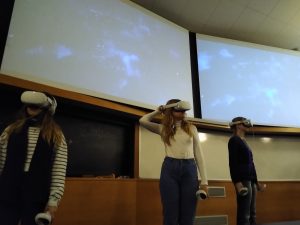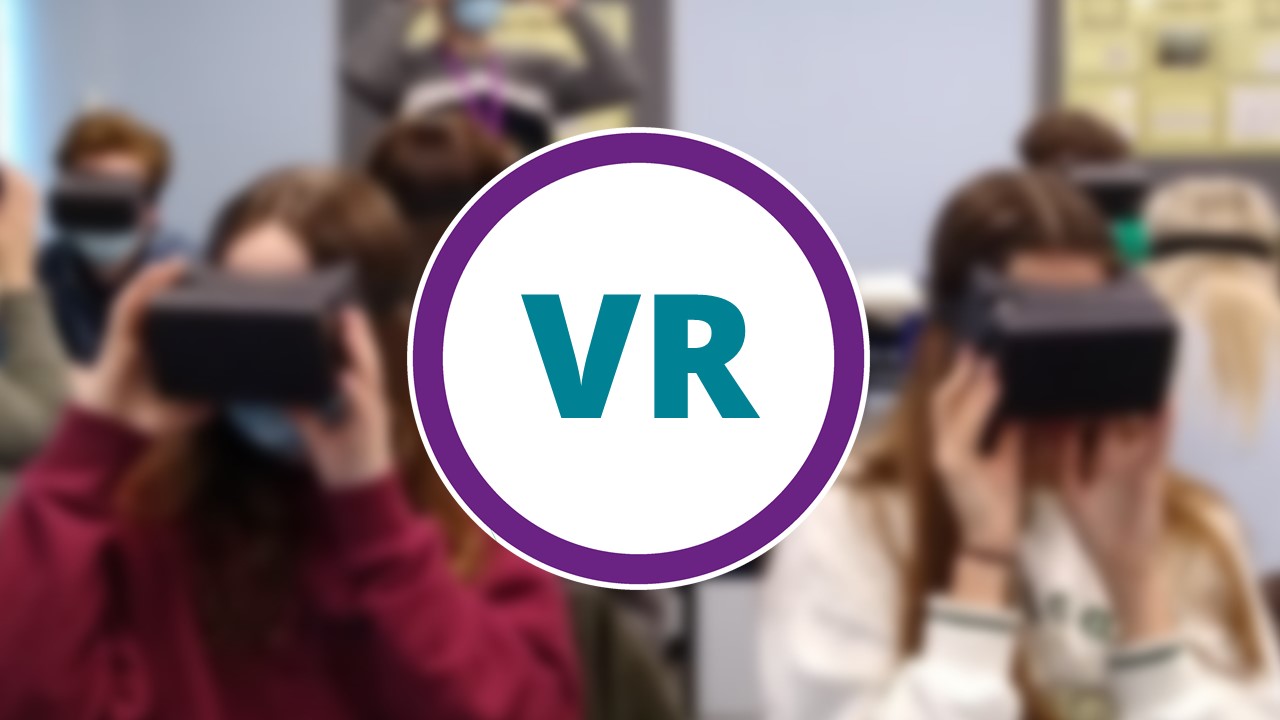Using Virtual Reality experiences for Psychology of Education
The project explored whether virtual reality technology can enhance the student experience and contribute towards students achieving the course unit independent learning objectives:
- Be able to outline the neurological processes involved in perceiving visual stimuli
- Identify the basic cognitive processes in visual perception
- Bottom-up / Top-down processing
- Depth Perception
- Visual Illusions
- Influence of prior knowledge and experience on perception
- Have experienced, through simulation, an introduction to visual impairment and an individual’s lived experience
Approach

Students using VR headsets
The project was a pilot supported by the Humanities eLearning Team using new virtual reality kit. One challenge was to see if the technology could be used successfully with students in a lecture setting, both from a practical level and in terms of improving the teaching and learning experience. The unit being studied is challenging given the specialist knowledge students are expected to acquire and often this means student are apprehensive. Through the provision of an innovative session, we sought to include an experiential element giving hands on experience that would be inspiring and directly impact student experience.
Virtual reality headsets were used as part of a lecture based around visual perception. Students used an app called ‘Notes on Blindness’, an immersive, interactive storytelling experience which creates a cognitive and emotional experience of blindness.
The app allowed students to experience an individual’s (British author, Professor John Hull) lived experience of gradual visual impairment, while also identifying the basic cognitive processes in visual perception.
Results
Due to the number of students in the session, four student volunteers used the VR headsets for the immersive experience while the remaining students viewed the experience on the lecture screen, relayed from a headset. This approach was practical and allowed the student group to all be included in the experience.
The app experience is also supported by a range of media resources allowing students to follow on their experience at a later date and continue to access relevant insights following the session.
Feedback was generally positive. Those students who did not use the VR headsets commented that their understanding and experience may have improved if they had used immersive virtual reality. This feedback is helpful to confirm that sufficient VR headsets should be provided so that so that all students can take part in the virtual experience. Similarly, for any students who would prefer not to use a VR headset it is helpful to have trialled viewing the experience relayed on a lecture screen making it accessible for all.
This feedback is helpful in informing how this pilot project can be improved for future VR sessions. For example, it helps inform us about the number of VR headsets needed for future sessions so that all students can take part in the virtual experience. Similarly, for any students who would prefer not to use a VR headset it is helpful to have trialled viewing the experience relayed on a lecture screen making it workable for all.
Evaluation / Student Feedback
Evaluation was integrated into the virtual reality lecture. Students were asked to complete an evaluation form after the session. Students were asked for feedback on using the VR technology and whether the experience helped to achieve the intended learning outcomes.
How well do you think you understood John Hull’s experience of going blind?
Very well. The headset experience was a mixture of both exciting and moving. It was very powerful to watch and experience, and immersing myself into John’s experience has given me an understanding that nothing else could have matched.
Interesting and the visual representations of general shapes appearing and disappearing with sound was effective at showing how a blind person may build a mental picture.
If you had to describe this experience to someone else, what would you tell them?
An incredible, insightful and enriching experience, unlike anything I have ever done before. This technology is outstanding.
Benefits
- Use of immersive technology to increase empathy and understanding
- Use of innovative technology to enhance the teaching and learning experience
- A teaching approach that is new and engaging
- A shared experience to stimulate discussion
Top Tips
- Contact the Humanities eLearning Team to arrange a consultation, including a hands-on demonstration of the virtual reality kit to find out how the technology can support your subject area.
- Start small – consider a pilot approach before using the technology with a large cohort.
- Think about how the technology can achieve your Intended Learning Outcomes.
- Include an opportunity for student feedback to gather thoughts on how virtual reality can support and enhance teaching and learning.
- Arrange equipment loans through the Humanities eLearning Equipment Lending Service.
- Find out more about Extended Reality and Immersive Technologies by visiting the XR web hub.

School: School of Environment, Education and Development (SEED)
Discipline: Education
Academic: Sarah MacQuarrie
Course: EDUC60741 Introduction to Neuroscience and Education
Cohort Size: 80
Themes: Teaching ideas, Enhancing learning with technology
Ref: 072

0 Comments